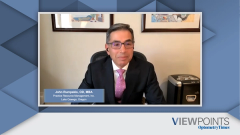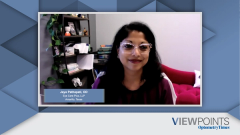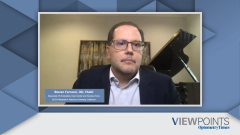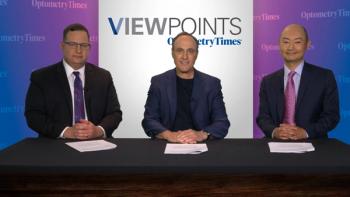
Integrating Retinal Monitoring Centers Into Clinical Workflows
Considerations for more widespread use of retinal monitoring centers based on clinician and patient feedback.
Episodes in this series

John Rumpakis, OD, MBA: I know you both have very busy practices. But having the ability to access this information at any time that you’d like, do you find it to be disruptive to your workflow, beneficial, easy to fit in in between patients, in the evening or in the morning?
Jaya Pathapati, OD: For me it’s been very easy. It’s on our desktop, and we have it downloaded in a couple of examination rooms, so I can look at it right before I’m going to go see a patient. Going back to what you said earlier, John, we’re almost doing a remote exam before we walk in the room. We’re looking at the OCTs [optical coherence tomography tests], we’re looking at the optomap or retinal photos before we walk in. We’re able to look at their chart, what their VA [visual acuity] is, and so forth. We’re outside the room, that’s kind of remote. We’re not even looking at the eye, correct? This is just a little more distant remote than outside the room. It’s been so easy, and, like I said, it’s now part of our flow, and it’s been great.
John Rumpakis, OD, MBA: This is becoming the pattern for the future. We start to get the patient more involved in their disease. As they become more involved, we probably end up being much more certain to get an early diagnosis, which helps with progression or early intervention on doing things. We have the ability to use technology to alert us, so that way we can use our medical decision-making, which is most valuable having real-time information. It certainly sounds like patient compliance is much higher with a remote monitoring type of a situation than it is with home Amsler grid that people have in the bottom of the drawer somewhere and bring it out when it’s time for their appointment. I’m glad to see that it fits into your workflow.
I want to talk a little bit about the economics of this. When we talk about billing processes for remote monitoring centers, as I said earlier, in the existing code we have for using it for a visual field assessment, the code is 0379T, which is a category 3 code. And this is the code that the billing center or the remote monitoring center uses to bill for the capture and the analysis of the test.
You get the results of the test, and it’s not a test that you get paid for, which is as I said earlier, a very important distinction because when we start to look at reviewing the data that you’re talking about, Jaya, before the patient comes in, you’re able to now score a higher level of evaluation and management [E&M] code because one of the categories, as you know, is complexity of data. When we’re looking at the complexity of data, we can’t count reviewing tests that we’ve done and done an interpretation report for, we can’t count that toward the E&M code. But we can count an outside test that somebody else has done. That can add to the complexity of the data that we have to review.
It’s an interesting thing because it does bring up the billing process. Right now, when you talk about how you bill for remote activities, my guess is neither one of you do, right, because there’s not really a pathway for you to bill for the visual field that’s being done in the ForeseeHome [monitoring program] that’s out there and doing it. But when we start to think about this, you are seeing the patient, so you’re billing an E&M code, you’re billing for ancillary testing you’re doing. In today’s world, with the changes in 2021 with the evaluation and management code requirements, you each have the choice. Steve, you don’t so much, but Jaya has the choice of being able to choose time as her basis for the code, or she has medical decision-making.
Now, time is an interesting thing because time has 9 different components that comprise it. And you can count this both ways because the time you take to review tests, if you’re going into the portal, you’re looking at the patient’s history of tests prior to doing that, every second you spend on that portal reviewing that patient prior to that examination would count toward the total time spent. That would impact, of course, your total time and that would impact your office visit level. When we start to think about the established patient E&M codes, and I don’t know if everybody is aware of this, but the impact of 2021 changes, the increase on the established patient side from 2020 to 2021 in the E&M codes was a significant increase in reimbursement, much more so than the new patient increase that we saw on doing that. Have you had any of your patients comment about the cost to them as far as the remote monitoring goes? Has that been a subject that you must tackle or educate patients about in any way?
Jaya Pathapati, OD: I have had nobody. I usually tell them that insurance will be billed through the remote monitoring service. I’ve had one patient call and say, “I can’t afford to do this because my insurance is not covering it.” And the remote monitoring service had a financial component where they reached out to help the patient who was not able to do it, and he was a high-risk patient. That really made me even more of a fan that they took the time to do that, and he’s still being monitored by it.
John Rumpakis, OD, MBA: Great. So, they do provide that kind of assistance and that kind of counseling work.
Jaya Pathapati, OD: Yes.
John Rumpakis, OD, MBA: That’s fabulous because sometimes that’s the biggest part that’s missing in a practice is describing the cost to a patient, understanding the impact at the point of care. It’s all nice, we always look at reimbursements and we look at different things like that. But when the rubber hits the road, we still have to make sure the patient is very comfortable in understanding how that process is going to work and what’s the responsibility of the third-party carrier versus their own responsibility.
Jaya Pathapati, OD: Right.
John Rumpakis, OD, MBA: That’s important.
Transcript edited for clarity.
Newsletter
Want more insights like this? Subscribe to Optometry Times and get clinical pearls and practice tips delivered straight to your inbox.













































